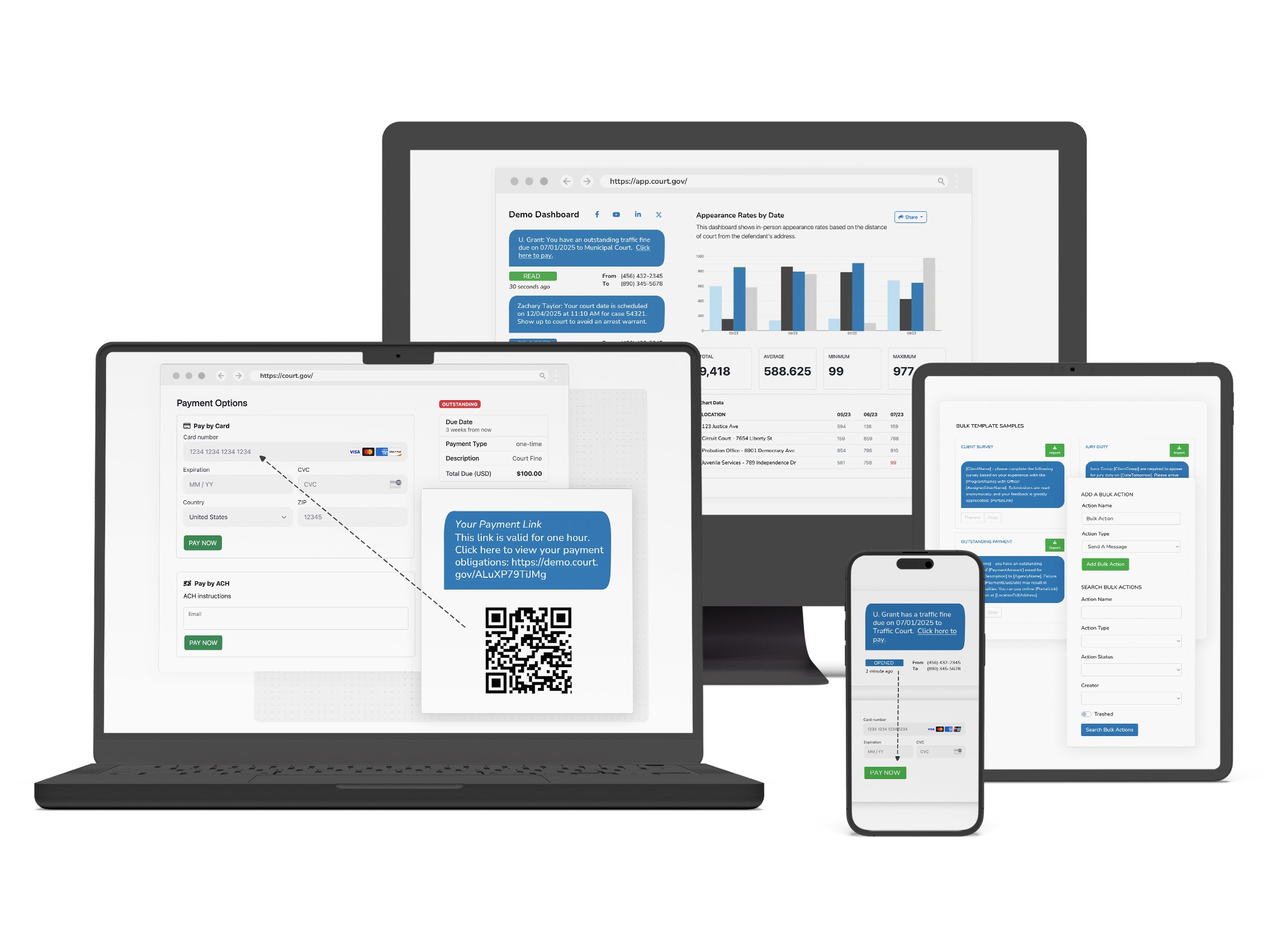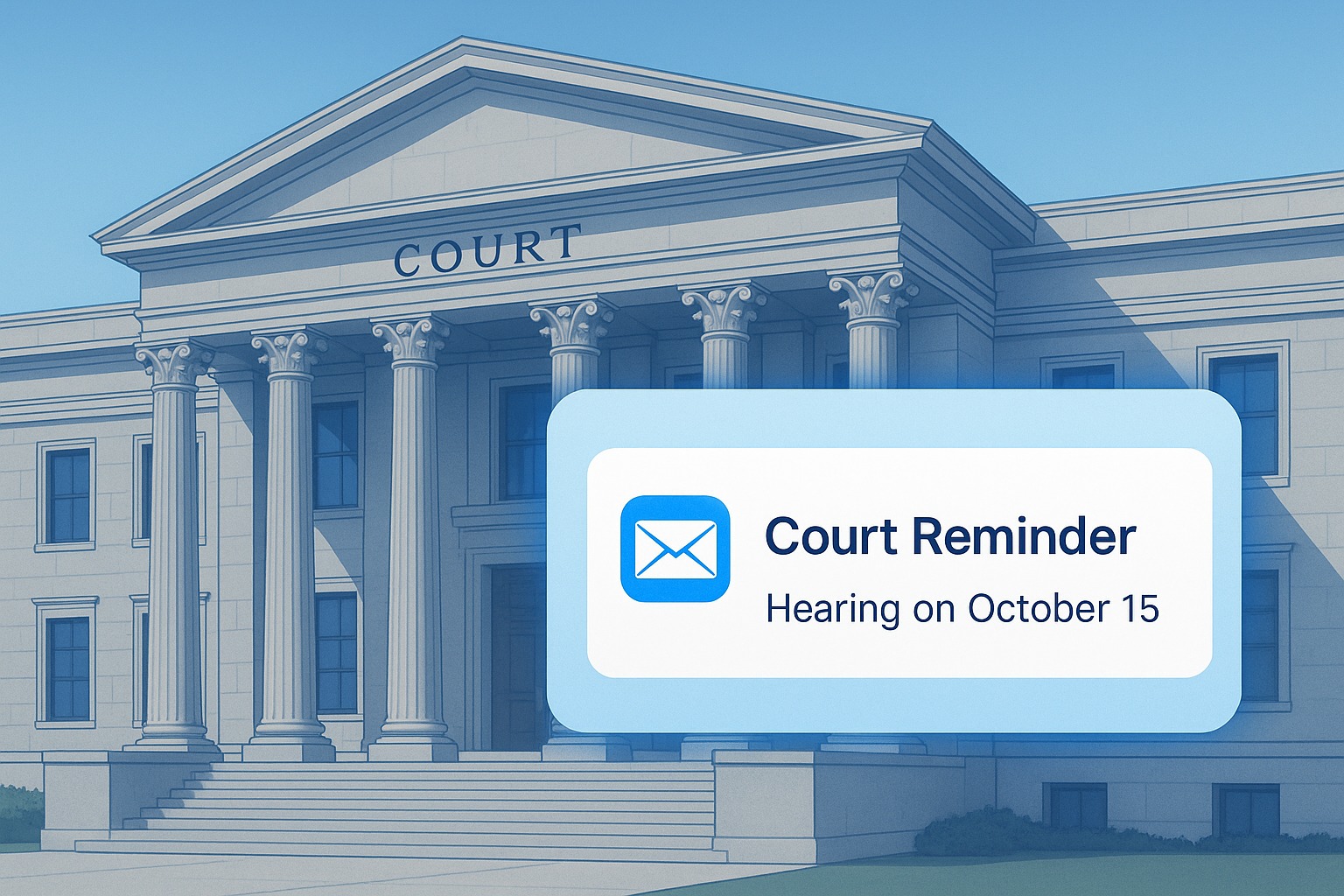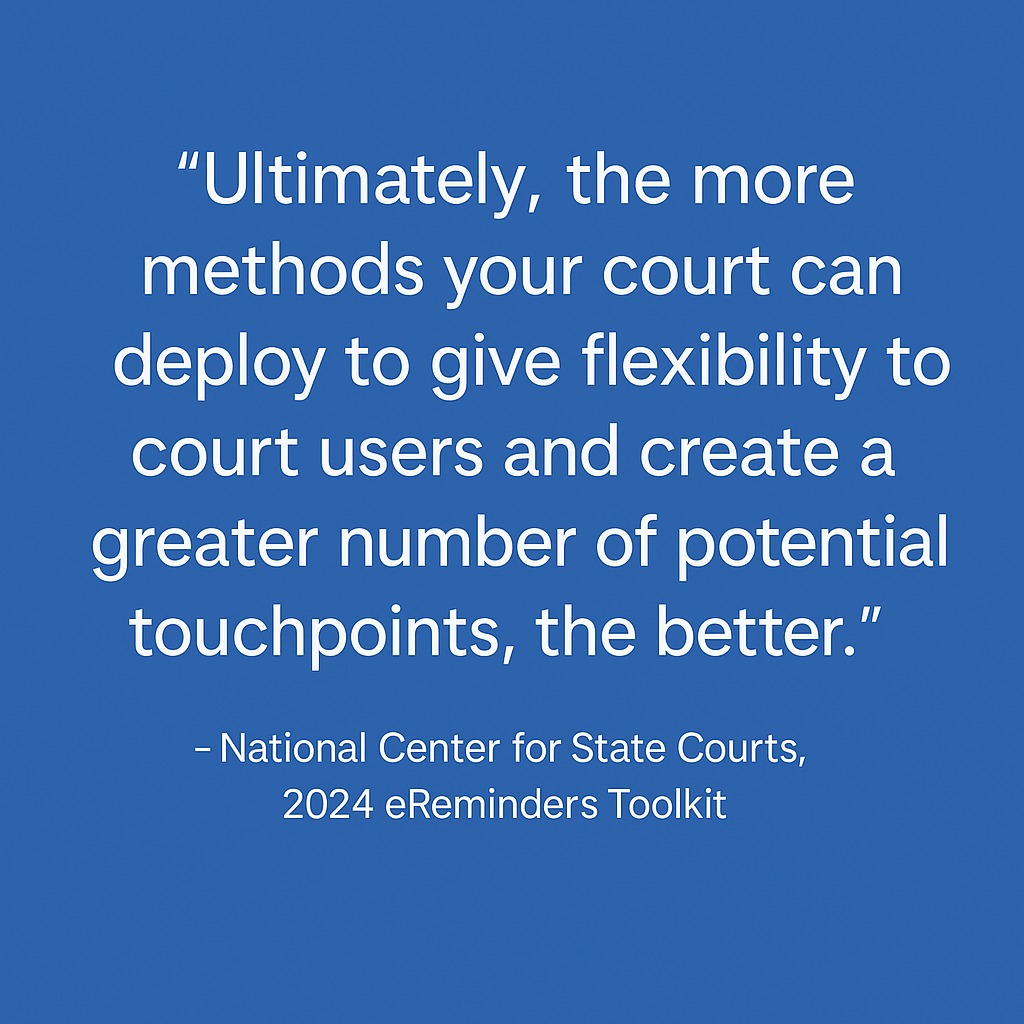Disclaimer: I am not a lawyer, and this article should not be taken as legal advice. It offers practical administrative methods based on federal and state compliance standards and the National Center for State Courts (NCSC) guidance on electronic reminders. Courts and agencies should always consult their attorney or legal counsel before implementing or changing communication policies.
Understanding the Landscape
Courts across the country are expanding their communication strategies to include email reminders for hearings, probation check-ins, fine deadlines, and other court events. Email allows for detailed messages, broader accessibility for people with limited phone service, and lower costs at scale, raising an important question: How do anti-spam laws apply to courts?
The short answer is that courts are generally exempt from commercial email rules, but they should still follow best practices that foster trust, protect privacy, and show transparency.
The primary federal law is the Controlling the Assault of Non-Solicited Pornography and Marketing (CAN-SPAM) Act of 2003. Unlike the TCPA, which governs text messages and calls, CAN-SPAM specifically covers commercial electronic mail messages mainly intended to advertise or promote a product or service.
Court emails containing procedural information about an existing case are classified as "transactional or relationship" messages under 15 U.S.C. §7702(17). They are informational and not promotional, so they are exempt from most of CAN-SPAM's commercial requirements.
What the Law Says
1. CAN-SPAM and the Transactional Exemption
Under the CAN-SPAM Act, commercial emails must include an unsubscribe link, a valid physical address, and accurate routing information. However, "transactional or relationship" emails that facilitate an existing relationship are not considered commercial.
A court email reminding someone of a hearing, fine, or procedural deadline clearly falls under this exemption. These messages are not advertisements; the recipient expects them as part of the legal process, and they are necessary to meet court requirements. Courts do not need prior consent or opt-in approval to send them.
2. Best Practices Even When Exempt
Even though court reminders are exempt, the Federal Trade Commission recommends that senders adhere to good-faith transparency standards:
- Use truthful and identifiable "From" names, such as Fantastic County Court Clerk.
- Write clear subject lines, such as "Court Reminder: Hearing on October 15."
- Avoid deceptive or alarming wording.
- Consider adding a clear "unsubscribe" or "update contact information" link to build trust.
Including the court's mailing address and phone number in the footer provides recipients with a straightforward way to verify the message's authenticity.
3. State Anti-Spam and Privacy Laws
Beyond federal law, several states have enacted their own anti-spam statutes. These mirror CAN-SPAM's intent—targeting commercial advertising—and generally exclude government communications. Court reminders do not fall into that category.
Texas Business and Commerce Code §321.002
This statute is part of the Texas Electronic Mail Solicitation Act (TEMSA). It mainly governs commercial electronic mail messages, which are messages sent to promote the sale of goods or services.
Key points:
- Scope: The law applies solely to commercial or promotional emails sent to or from a computer in Texas that aim to encourage the purchase or sale of property, goods, or services.
- Exemptions: It does not apply to transactional, governmental, or informational communications that lack a solicitation component.
- Prohibitions: It prohibits false or misleading transmission information or subject lines, even in partially commercial messages.
In short, if a message's purpose is to promote a sale, §321.002 applies. If the message is informational, governmental, or transactional, it does not. Court reminders clearly fall into the latter category.
California Business and Professions Code §17529.5
This statute is part of the California Anti-Spam Act. It prohibits deceptive or misleading header information or subject lines, but applies only to unsolicited commercial email advertisements.
Key points:
- Scope: The statute applies to unsolicited commercial emails that promote the sale, lease, or exchange of goods or services.
- Prohibitions: It is illegal to falsify, misrepresent, or forge header information, use deceptive subject lines, or send emails through third-party domains without authorization.
- Exclusions: It does not apply to purely transactional, informational, or government communications lacking a commercial advertising purpose.
Colorado and Florida Context
Colorado's deceptive email statute (Colo. Rev. Stat. §6-1-702.5) applies only to commercial electronic mail messages. It prohibits sending such messages with false or misleading transmission or routing information, or in violation of the federal CAN-SPAM Act.
Florida's Computer Crimes Act (Fla. Stat. §§668.601–606) and Deceptive and Unfair Trade Practices Act (Fla. Stat. §501.201 et seq.) contain similar restrictions on deceptive or falsified commercial email practices. These laws apply only to commercial or trade communications and do not extend to noncommercial governmental messages such as judicial reminders.
Summary
In Texas, California, Colorado, and Florida, these laws aim to prevent misleading or promotional email marketing. Judicial reminder emails are not considered commercial solicitations and are therefore not subject to these laws. However, courts should protect personal data and include brief privacy notices when collecting email addresses, explaining how the information will be used and how it will be secured.
Administrative Practice and NCSC Guidance
The NCSC eReminders Toolkit (2024) and Ideas42's Improving Court Attendance Guide (2025) offer detailed operational guidance for courts using electronic reminders. Both suggest that courts combine email, text, and mail notifications to ensure no one is left out due to technological barriers.
Key findings from NCSC and Ideas42 include:
- Multi-channel communication is most effective. Gather both phone numbers and email addresses, and let participants select their preferred contact method.
- Emails can provide more context. They can include instructions, attachments, or translation links without character limits.
- Timing is essential. Since people tend to check email less often than texts, send reminders 14, 7, and 1 day before the hearing.
- Automatic enrollment with an opt-out option is fairer. Requiring sign-ups leaves out many who need reminders most.
- Use official domains like .gov or .us to boost deliverability and public confidence.
Accessibility and Trust
Effective communication must be lawful, understandable, and accessible to everyone.
1. Plain Language and Tone
Court emails should use short sentences, simple vocabulary, and a supportive tone.
"You have a court hearing on Tuesday, October 15, at 9:00 a.m. in Courtroom 3."
Avoid formal legal phrases such as "You are hereby notified of an appearance." Research from Ideas42 shows that plain language reduces anxiety and increases compliance.
2. Sender Identity and Authenticity
People are more likely to open emails from verified sources. Courts should:
- Send from an official government domain such as @county.state.us or @courts.state.gov.
- Use a recognizable "From" name that includes "Court" or "Clerk's Office."
- Add a footer such as: "This is an official email from [Court Name]. You can verify this reminder by calling [phone number] or visiting [court website]."
3. Accessibility (ADA and Section 508 Compliance)
All court emails must be readable by people with disabilities and compatible with assistive technologies.
- Use a simple single-column layout with legible fonts such as Arial or Calibri, size 12 or larger.
- Maintain strong color contrast and avoid patterned backgrounds.
- Include alternative text for images such as court seals or logos.
- Use descriptive links, such as "View Directions to Courthouse," rather than "Click here."
- Avoid all capital letters and long italicized sections, which are harder to read for people with vision or cognitive disabilities.
4. Language Access
Where possible, include bilingual text or a link to translated content. Even a short line such as "Para información en español, visite [link]." improves access for limited-English-proficiency users and meets Title VI expectations.
Recommended Operational Model
At eCourtDate, our approach to email compliance follows the same logic as our text-messaging model: transparency, accuracy, and accountability.
- Collect and verify email addresses during case intake.
- Clearly disclose that emails will be used for official court reminders.
- Send from official government domains or approved communication platforms such as GovDelivery or Granicus.
- Use accurate subject lines and recognizable sender names.
- Provide a simple opt-out option for transparency.
- Maintain logs of all messages, delivery confirmations, and opt-outs.
- Exclude any content that could appear promotional or commercial.
This approach protects the court, respects recipients, and strengthens public confidence.
Balancing Law and Access
Legal compliance and fair access work best when combined.
The CAN-SPAM Act and state laws such as the Texas Electronic Mail Solicitation Act, the California Anti-Spam Act, and similar provisions in Colorado and Florida set clear limits on commercial communication. The NCSC and Ideas42 frameworks help courts interpret these standards to promote fairness, accessibility, and transparency.
Courts that adopt both views will increase appearance rates, reduce missed hearings, and build greater trust between the justice system and the community.
Disclaimer
This article is for informational purposes only and does not constitute legal advice. Always consult your attorney or legal counsel before implementing any messaging program.
References (for informational use only)
- CAN-SPAM Act of 2003, 15 U.S.C. §7701 et seq.
- Federal Trade Commission. (2024). CAN-SPAM Compliance Guide for Business.
- National Center for State Courts. (2024). eReminders Toolkit. Williamsburg, VA.
- Ideas42. (2025). Improving Court Attendance: The Essential Guide to Court Reminder Programs. New York, NY.
- CTIA. (2023). Messaging Principles and Best Practices.
- Texas Business and Commerce Code §321.002 (Texas Electronic Mail Solicitation Act).
- California Business and Professions Code §17529.5 (California Anti-Spam Act).
- Colorado Revised Statutes §6-1-702.5.
- Florida Statutes §§668.601–606 and §501.201 et seq.
- U.S. Department of Justice. (2023). ADA and Section 508 Accessibility Requirements.
- Digital.gov. (2024). Plain Language and Accessible Email Design Standards.


About Greg Shugart
Director of Government Relations
Greg Shugart brings over 30 years of public sector experience to the eCourtDate team, with a background in court administration, criminal justice reform, and government operations. He previously served as Criminal Courts Administrator for Tarrant County, Texas, where he led statewide-recognized initiatives in pretrial modernization, court communications, and system efficiency. Greg now contributes to eCourtDate’s strategy and partnerships, helping agencies implement technology that improves access, compliance, and trust in the justice system.

